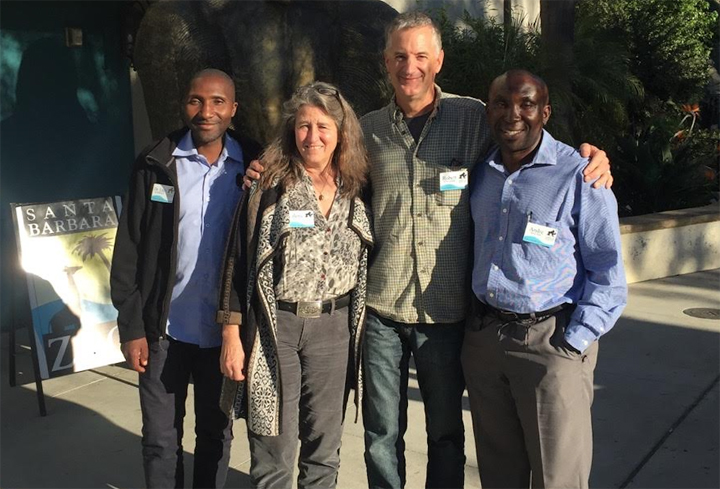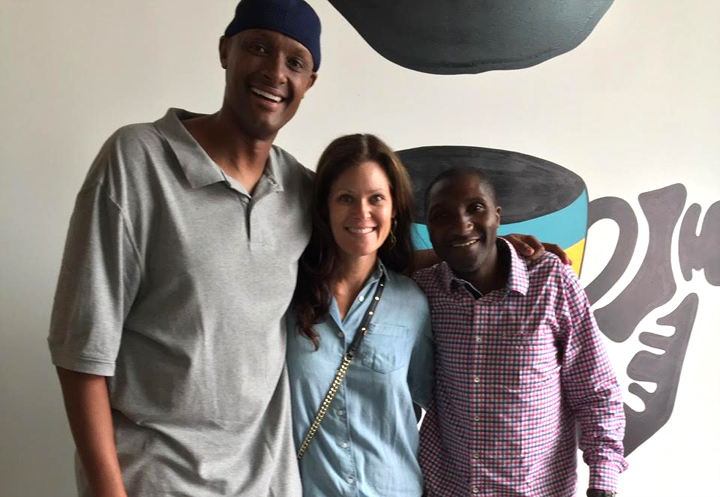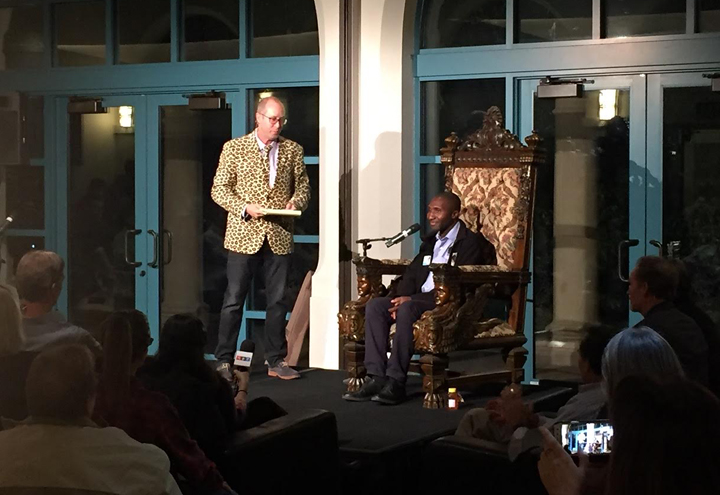DRC Head Field Vet Dr. Eddy Travels to California for Gorilla Workshop
By Gorilla Doctors Staff on Tuesday, November 21st, 2017 in Blog.by Dr. Eddy Kambala Syaluha
On October 15, 2017, I was honored to receive an invitation from the Santa Barbara Zoo (through the DRC wildlife institution, Institut Congolais pour la Conservation de la Nature / Virunga National Park) to attend the Western Regional Gorilla Workshop in California. This was to be an all-expenses-paid trip for me, courtesy of the Happy Hollow Zoo in San Jose. I only had two weeks before the workshop was to take place on November 6-8, so Gorilla Doctors staff worked quickly to process the visa in time and make all the necessary preparations. Andre Bauma, the head caregiver of the four mountain gorilla orphans at the Senkwekwe Center, was also invited to attend the workshop. Andre and myself were invited to attend because we have both been working with the last captive and wild endangered Eastern gorilla species (mountain and Grauer’s gorillas) for a long time now and our experience, expertise and knowledge-sharing was considered to be important to the workshop.
Approximately 50 gorilla veterinarians and keepers from zoos around the USA attended the workshop in Santa Barbara. During these three days, a variety of topics were covered including: best practices in gorilla health care, gorilla pathology, specialized diets and wound management of gorillas in captive care. This was a unique opportunity for Andre and I to connect with other gorilla experts and bring home new ideas to improve our management of the captive gorilla orphans to the highest international standard.

Dr. Eddy and Andre Bauma with Valerie Riegel, Director of Happy Hollow Park & Zoo and Robert Williams of the Virunga Foundation.
When we arrived in California, Andre and I had Sunday, November 5th free to explore before the workshop began. We were lucky to visit the San Diego Zoo Safari Park and participated in gorilla rounds with the Park’s caregivers. They gave us a short briefing of their daily gorilla management, as well as an overview of health issues they are facing, mostly with their geriatric gorillas. Afterwards, we did rounds with the senior veterinarian and participated in a procedure to x-ray the tusks of an elephant. Then we toured the Park’s hospital, which I found to be very well-equipped. We ended the visit with a tour of the Park’s rhinoceros breeding program.
That evening, we arrived at the Santa Barbara Zoo and we were ready to participate in the workshop, starting with Zoo rounds on November 6. That evening, Andre and myself were interviewed about our daily activities with DRC’s eastern gorillas and the next evening there was event unlike anything I had ever experienced, complete with a comedy team! Many people were invited to the Zoo to enjoy the event and Andre and I were among the actors. A King’s chair was placed in the middle of the conference room and I was the first to jump in it. The moderator of the Ceremony, the Zoo’s marketing director, posed the question “Who inspired you to become a veterinarian?” I said that my father was a farmer and raised turkeys, chickens and goats and the comedians created a song about my story. Together we started singing and dancing about what my father used to say to us to take care of the turkeys and goats.
While in Santa Barbara, I had the opportunity to visit with many wonderful Gorilla Doctors donors, I then flew up to Seattle, Washington to join Dr. Kirsten Gilardi, our US Director, at an evening fundraising event held at Verna and Attila Kilic’s house. Verna and Attila traveled to Rwanda and met Dr. Kirsten on a gorilla trek there, where they became friends and kept in touch. The gathering at the Kilic’s home was so enjoyable and after speaking with everyone, I truly realized how many people follow our daily field activities: to my surprise they discussed detailed stories of many of our interventions and routine health checks. I was very proud to hear from many American people how much they appreciate the work we do to save endangered species. From Seattle, Kirsten and I traveled to Davis, California, the US headquarters for Gorilla Doctors, where I was lucky to meet with former colleagues of Dr. Dian Fossey, Kelly Stewart and Sandy Harcourt, who talked about their efforts to help snared gorillas long ago, before there were Gorillas Doctors veterinarians on site.
From Davis, we travelled back south to Los Angeles to meet with other Gorilla Doctors friends and donors at a reception hosted by Gorilla Doctors Boardmember Jack Karuletwa and his wonderful wife Jennifer and their son Wyatt. We enjoyed the great Rwandan coffee at Jack’s Silverback Coffee of Rwanda Café and met with so many interesting and passionate gorilla lovers. So many people expressed their gratitude for the work of Gorilla Doctors and we received additional donations to support our daily work. I am so grateful to those who hosted us in their home, took care of us and shared this wonderful experience with us.

Gorilla Doctors Board Member Jack Karuletwa, his wife Jennifer and Dr. Eddy at Silverback Coffee Cafe in LA.
Traveling back to Africa, I reflected on how grateful I am to those who hosted us in their homes and businesses, and who shared their wonderful experiences with us. Then I started reading reports on sick gorillas and got ready to get back to work. I spent only 12 hours at home with my family and in the very early morning, I headed up to the Bukima patrol post to assess one of the silverbacks of Rugendo group named Noel. Noel is a silverback which makes every visit memorable and impressive through his games and displays. Unfortunately, the big male was reportedly lethargic and not leaving his night nest and in need of a veterinary assessment. We have intervened three times to administer medical treatment and are hoping that the silverback pulls through… but that is for another blog!


 Donate
Donate
